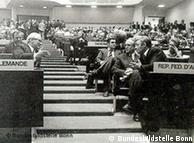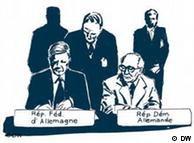History | 16.11.2009
The Helsinki Accords - August 1, 1975
 Bildunterschrift: Großansicht des Bildes mit der Bildunterschrift: Thirty-five nations took part in the CSCE
Bildunterschrift: Großansicht des Bildes mit der Bildunterschrift: Thirty-five nations took part in the CSCE
On the initiative of the Warsaw Pact, the first Conference on Security and Cooperation in Europe (CSCE) was held in Helsinki on July 3, 1973. All European nations, with the exception of Albania, were in attendance. The goal was to improve relations between the Communist bloc and the West (NATO and the EEC).
While Western Europe was organized in capitalist, democratic forms of government, Eastern Europe was made up of Communist or socialist states. The series of conferences was meant to contribute to peace and de-escalation in Europe, but without negating the different political mindsets of the two blocs, or making propagandistic judgments about the other side's views.
From confrontation to cooperation
 Bildunterschrift: Großansicht des Bildes mit der Bildunterschrift: Former German Chancellor Helmut Schmidt
Bildunterschrift: Großansicht des Bildes mit der Bildunterschrift: Former German Chancellor Helmut Schmidt
On August 1, 1975, after two years of negotiations, the signatories guaranteed the following: inviolability of frontiers; territorial integrity of states; peaceful settlement of disputes; non-intervention in internal affairs, avoidance of threat or use of force; sovereign equality; equal rights and self-determination of peoples; and respect for human rights and fundamental freedoms, including the freedom of thought, conscience, religion or belief.
What sounded like dry diplomatic speak was in fact a political sea change on the European continent - from confrontation to cooperation. The signatories were in effect promising to stop pursuing each other's downfall, and instead to emphasize the superiority of their own political system.
 Bildunterschrift: Großansicht des Bildes mit der Bildunterschrift: East German leader Erich Honecker
Bildunterschrift: Großansicht des Bildes mit der Bildunterschrift: East German leader Erich Honecker
For the first time since the end of World War II, the western states accepted the borders on the continent. That also went for the controversial German-Polish border on the Oder-Neisse line, which had previously been recognized in a treaty (Treaty of Warsaw) between Poland and the social-liberal coalition of West Germany. While Eastern European states saw this part of the Helsinki Accords as a political breakthrough, the Western European states played up the commitment to upholding human rights in the states of the Communist bloc. Both contributed to a de-escalation on the European continent.
The following morning, as agreed upon in Helsinki, every signing country published the text of the accords.
Consequences
 Bildunterschrift: Großansicht des Bildes mit der Bildunterschrift: Vaclav Havel
Bildunterschrift: Großansicht des Bildes mit der Bildunterschrift: Vaclav Havel
The effect was enormous, as people all across the continent could see in black and white that borders had been granted inviolability, and that human rights were to be respected even in places where that had hitherto not been the case. In the initial months after the CSCE, many observers were of the opinion that the Eastern bloc was the actual winner of the process. But a few years later, it became clear that the Eastern European states' promise to uphold human rights was of ever-increasing significance. It wasn't long before dissident groups in East Germany (Swords into Plowshares) and Poland (Solidarity) were referring to the Helsinki Accords. The "Charter 77," which was signed by future Czechoslovakian President Vaclav Havel mong others, referenced the fact that the Czech government had committed to safeguarding human rights in Helsinki. This situation prevented governments in the Eastern bloc from repressing opposition movements with military means, as had been the case in East Berlin (1953), Hungary (1956) or Prague (1968).
Even though some Eastern European states attempted to silence civil rights movements with massive state violence, the Helsinki Accords remain the most significant document on Europe's path from a divided to a united continent. The CSCE process, which began at the behest of the Eastern bloc with the aim of securing their territorial integrity, ended up becoming a significant factor in the bloc's collapse between 1975 and 1990. As a result of this geo-strategic change, the East-West conflict - which had repeatedly brought Europe to the brink of a third, atomic world war since the end of World War II - was finally resolved.
Author: Matthias von Hellfeld (dc)
Editor: Andreas Illmer

Comments